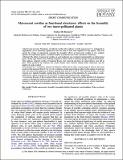Por favor, use este identificador para citar o enlazar a este item:
http://hdl.handle.net/10261/36758COMPARTIR / EXPORTAR:
 SHARE SHARE
 CORE
BASE CORE
BASE
|
|
| Visualizar otros formatos: MARC | Dublin Core | RDF | ORE | MODS | METS | DIDL | DATACITE | |

| Título: | Marcescent corollas as functional structures: effects on the fecundity of two insect-pollinated plants |
Autor: | Herrera, Carlos M. CSIC ORCID | Palabras clave: | Corolla marcescence Fecundity Lavandula latifolia (Lamiaceae), seed predation Viola cazorlensis (Violaceae). |
Fecha de publicación: | oct-2010 | Editor: | Oxford University Press | Citación: | Annals of Botany 106: 659 – 662, 2010 | Resumen: | † Background and aims Persistence of withered corollas after anthesis (‘corolla marcescence’) is widespread in angiosperms, yet its functional significance does not seem to have been explored for any species. This note reports the results of experiments assessing the fecundity effects of marcescent corollas in two southern Spanish insect-pollinated plants, Lavandula latifolia (Lamiaceae) and Viola cazorlensis (Violaceae). † Methods The effect of marcescent corollas on seed production was evaluated experimentally on wild-growing plants. Newly open flowers were randomly assigned to either control or treatment groups in experimental plants. After anthesis, withered corollas of treatment flowers were removed and those in control flowers were left in place. Fruits produced by treatment and control flowers were collected shortly before dehiscence and the number of seeds counted. † Key Results In V. cazorlensis, removal of withered corollas had no effect on percentage of fruit set, but mean seeds per fruit increased from 9.5 to 11.4. In L. latifolia, corolla removal had no effect on the number of seeds per fruit, but reduced the proportion of flowers ripening fruit from 60 % to 40 %. The detrimental effect of corolla removal on L. latifolia fecundity resulted from the drastic increase in fruit infestation by seed-predatory cecido- myiid larvae, which occurred in 4 % and 34 % of control and treatment fruits, respectively. † Conclusions Because of their potential effects on plant fecundity, marcescent corollas should not be dismissed a priori as biologically irrelevant leftovers from past floral functions. The simplicity of the experimental layout required to test for short-term fecundity effects of corolla marcescence should help to achieve a better understand- ing of the ecological and evolutionary correlates of this widespread but poorly understood trait. | Versión del editor: | http://aob.oxfordjournals.org/content/106/4/659.full.pdf+html | URI: | http://hdl.handle.net/10261/36758 | DOI: | 10.1093/aob/mcq160 |
| Aparece en las colecciones: | (EBD) Artículos |
Ficheros en este ítem:
| Fichero | Descripción | Tamaño | Formato | |
|---|---|---|---|---|
| Herrera.2010.Ann.Bot.pdf | 145,78 kB | Adobe PDF |  Visualizar/Abrir |
CORE Recommender
PubMed Central
Citations
1
checked on 10-abr-2024
SCOPUSTM
Citations
5
checked on 17-abr-2024
WEB OF SCIENCETM
Citations
6
checked on 28-feb-2024
Page view(s)
276
checked on 24-abr-2024
Download(s)
176
checked on 24-abr-2024
Google ScholarTM
Check
Altmetric
Altmetric
Artículos relacionados:
NOTA: Los ítems de Digital.CSIC están protegidos por copyright, con todos los derechos reservados, a menos que se indique lo contrario.
